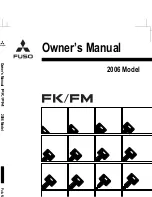
13-38
Useful advices for emergencies
•
Position the tow rope on the same side of both
vehicles.
•
For the sake of safety, the angle formed by the
tow rope when hooked up should be limited to
the range indicated in the illustration. Do not tow
a vehicle under conditions which could impose
sudden undue stress on the hooks (for instance,
towing a vehicle out of a ditch) as doing so could
break the hooks. Also, never attempt to tow a
vehicle that is heavier than your own vehicle.
NOTE:
The maximum load permitted on the tow hook is
14,700 N (1,500 kgf) when applied in the direction
of towing.
•
The cargo on the disabled vehicle should be
completely unloaded.
•
Limit the maximum speed to 30 km/h unless the
vehicle is towed with a special towing vehicle.
•
Avoid sudden starts and keep the tow rope taut.
•
The broken down vehicle should be prepared for
towing as follows:
1. In a manual transmission vehicle, put the gear
shift lever in the neutral position.
In a vehicle with DUONIC system, put the gear-
shift lever in the “P” position.
2. Keep the engine running.
Stopping the engine while the vehicle is moving
is extremely dangerous because it drastically
reduces braking performance and makes the
steering action extremely heavy.
CAUTION
•
If the transmission, transfer <FG models> or
differential is defective, do not tow the vehi-
cle. Instead, call your nearest authorized
MITSUBISHI FUSO distributor or dealer.
•
Before towing a 4WD vehicle, raise the front
wheels and disconnect the propeller shaft at
the rear.
Z18431
Z18432
Summary of Contents for CANTER
Page 23: ...2 1 Labels inside the cab 2 3 Exterior labels 2 6 2 Warning labels ...
Page 325: ...12 23 Z22021 FG ...
Page 454: ...13 35 Z22249 Z21702 ...
Page 464: ...15 1 15 Alphabetical index ...
































